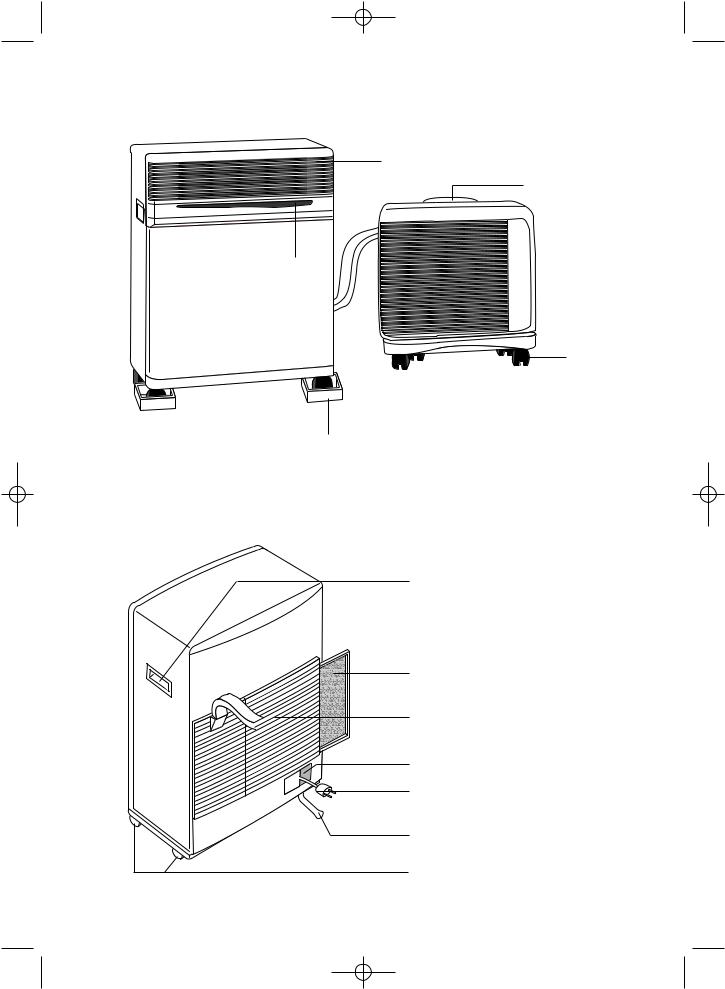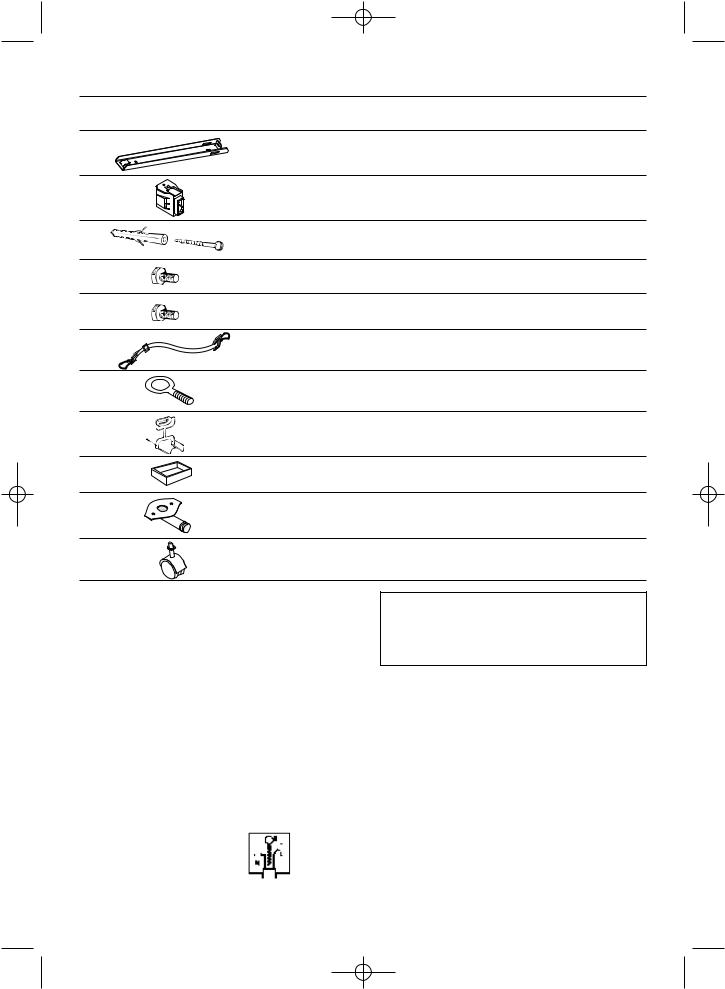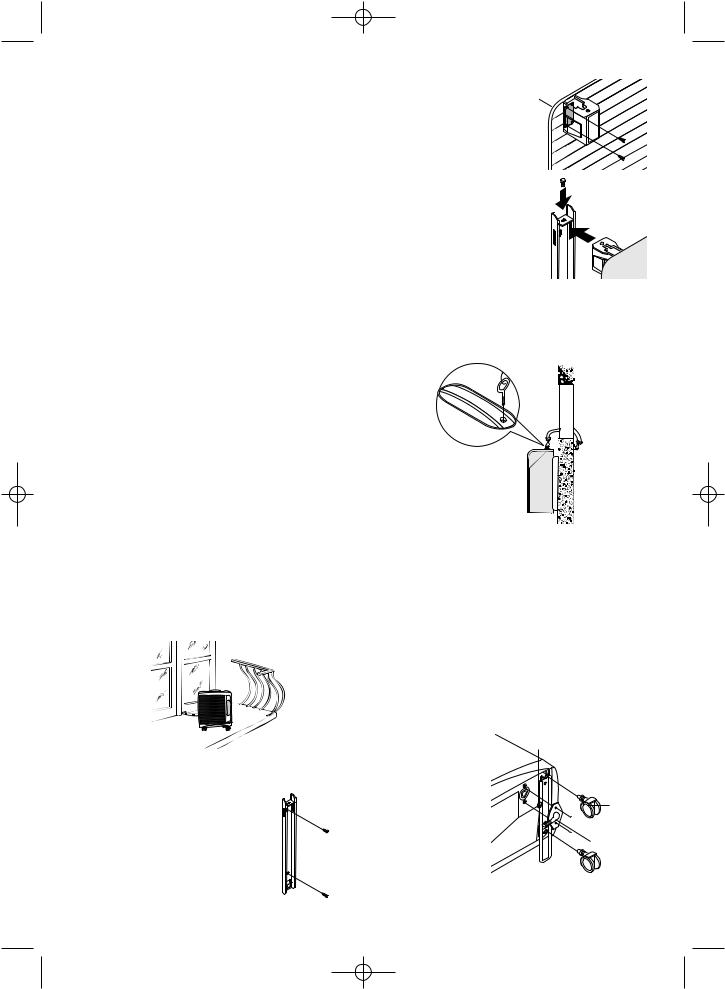Delonghi PACCS 600ECO Instructions Manual

GB-5750004200 11-02-2004 9:12 Pagina 16
Carefully read this instructions booklet before installing or using this appliance.
Only by doing so will you have the best results and enjoy the greatest safety when using the appliance. Please pay particular attention to the warnings on page 28.
INTRODUCTION
This is a conditioner of the air-to-air type composed of two units: one internal (which operates inside the room) and the other external (to be installed outside). These two units are joined together by a sheathing (of about 3 m.) containing the refrigerant pipes, electrical power cables and condensation-discharge tube.
TECHNICAL FEATURES
Power supply |
|
|
|
voltage |
See the features plate |
||
Maximum absorbed power |
“ |
||
Cooling capacity* |
|
“ |
|
Max. air flow rate |
|
560 m3/h |
|
Flexible tube length |
|
3 m |
|
Sheathing section |
|
20 x 44 mm |
|
Dimensions: indoor unit |
|
|
|
• |
length |
|
560 mm |
• |
height |
|
735 mm |
• |
depth |
|
355 mm |
• |
weight |
|
44 kg |
Dimensions: outdoor unit |
|
|
|
• |
length |
|
570 mm |
• |
height |
|
480 mm |
• |
depth |
|
260 mm |
• |
weight |
|
18 kg |
*Standard conditioning:
Inside temperature |
27°C |
|
relative humidity: 47% |
Outside temperature |
35°C |
|
relative humidity: 41% |
OPERATIONAL AIR-
CONDITIONING LIMITS
Room temperature |
21 ÷ 32°C |
Outside temperature |
21 ÷ 43°C |
16

GB-5750004200 11-02-2004 9:12 Pagina 17
DESCRIPTION
Air delivery grille
External unit handle
Forced operations button
Castors
EXTERNAL UNIT
INTERNAL UNIT
Castor stop
INTERNAL UNIT
Carrying handle
Removable filter
Air intake grille
Power cable compartment
Power cable
Condensation drainage tube
Castors
17

GB-5750004200 11-02-2004 9:12 Pagina 18
ACCESSORIES
DRAWING |
DESCRIPTION |
NO. PIECES PROVIDED |
Wall-attachment bracket |
2 |
|
Support block for external unit |
2 |
|
|
||
Anchor screws + screws ø 6 mm |
4 |
|
Screws M6 mm |
2 |
|
Screws M4x25 mm |
4 |
|
Belt with hooks |
2 |
|
Screw eye for a belt |
2 |
|
Sheathing frame |
1 |
|
Castor stop |
2 |
|
Drain connection for condensation |
1 |
|
with seal and two 4.2 penetrating |
||
screws |
|
|
Castors |
for the external unit and |
4 |
washers |
|
|
|
|
|
TECHNICAL SERVICE
Keep the list of Technical Service Centres in a safe place and check to find the closest Centre (though we hope you will never have to seek their help).
ELECTRICAL CONNECTION (U.K. ONLY)
A)If your appliance comes fitted with a plug, it will incorporate a 13 Amp fuse. If it does not fit your socket, the plug should be cut off from the mains lead, and an appropriate plug fitted, as below.
WARNING: Very carefully dispose of the cut off plug after removing the fuse: do not insert in a 13 Amp socket elsewhere in the house as this could cause a shock hazard.
With alternative plugs not incorporating a fuse, the circuit must be protected by a 15 Amp fuse.
WARNING - THIS APPLIANCE MUST BE EARTHED
IMPORTANT
The wires in the mains lead are coloured in accordance with the
following code: |
|
Green and yellow: |
Earth |
Blue: |
Neutral |
Brown: |
Live |
This appliance has been fitted with an HE (High Efficiency) system for low energy consumption, so after turning the appliance on you may have to wait a few minutes for cool air to begin circulating.
If the plug is a moulded-on type, the fuse cover must be re-fitted when changing the fuse using a 13 Amp Asta approved fuse to BS 1362. In the event of losing the fuse cover, the plug must NOT be used until a replacement fuse cover can be obtained from your nearest electrical dealer. The colour of the correct replacement fuse cover is that as marked on the base of the plug.
B)If your appliance is not fitted with a plug, please follow the instructions provided below:
As the colours of the wires in the mains lead may not correspond with the coloured markings identifying the terminals in your plug, proceed as follows:
The green and yellow wire must be connected to the terminal in the plug marked with the letter E or the earth symbol  or coloured green or green and yellow.
or coloured green or green and yellow.
The blue wire must be connected to the terminal marked with the letter N or coloured black.
The brown wire must be connected to the terminal marked with the letter L or coloured red.
18

GB-5750004200 11-02-2004 9:12 Pagina 19
INSTALLATION
The sheathing that connects the external to the internal unit may pass:
a) through a slightly-open window or door;
In this case, the hook-ups with the external unit must be disconnected as follows:
1)Remove the plug from the electric outlet;
2)Remove the handle by loosening the two screws and then slipping off the facing.
SHEATH STOP
ELECTRIC
HOOK-UP
SHIELD
U BOLT
b)through a small hole (5.5 cm x 2.5 cm) drilled in the lower part of a door or in a window frame by using the frame provided.
3)
4)
5)
Remove the U bolt by |
the two |
screws. |
|
Remove the sheath stop by loosening the two screws.
Using a 24-version wrench, unscrew the union on the coupling. At the same time, hold the end of the flexible tube tight by using a 21-version wrench. Repeat this operation for the second union using a 24and a 19-version wrench.
USE OF RAPID COUPLINGS
In addition to the methods described above, the sheathing that joins the external to the internal unit may also be drawn through a hole (about 6 cm. in diameter) drilled in a wall linked to the outside.
ø6 



cm |
30 |
|
6)Disconnect the condensation tube from the rubber holder.
7)Loosen the shield’s two self-threading screws and disconnect the electric hook-up unit.
The path of the connecting sheath should be as straight as possible, without sharp curves or kinks.
19

GB-5750004200 11-02-2004 9:12 Pagina 20
To re-connect the detached ends of the sheath to the internal unit, you must repeat operations 1 through 7 in reverse order, being careful to observe the following precautions:
•Before drawing the sheath through the hole in the wall, you should wrap the threaded ends of the speedy couplings with friction tape or the like as a protective measure.
•Fit the upper two cooling junctures into the two lower ones and hand-screw them several turns while checking to be certain they are well-fit- ted, and then tighten them with the wrenches used earlier.
•After having hooked up the two cooling junctures, tighten the U bolts.
•Check the grip on the cooling junctures by wetting the joints with a little soapy water.
No bubbles should appear.
Caution:
We recommend that the disconnecting and connecting of the rapid couplings be carried out only by qualified technicians.
INTERNAL UNIT
Install the internal unit inside the room to be airconditioned. This is usually done under a window or at least close to an outside wall.
The internal unit must be placed “on the level”, with the help of the castor-stops provided. No obstacles should block this unit’s in-take (suction grille) or out-take (outlet grille) areas.
EXTERNAL UNIT
The external unit may be placed on a terrace or balcony, in which case the brackets need not be used.
The external unit can be attached to a wall with the accessories included as follows:
1) Attach the bracket to the
wall while taking care to place it as indicated in the
drawing. Use the included template located on the
plastic cover in order to drill the holes.
2) Screw the support blocks to the external unit with the included M4mm screws while taking care to place them so that the hole for the screws is on the upper side.
3) Attach the external unit to |
2 |
|
the bracket by means of |
||
|
||
the M6mm screws. |
|
1
For temporary installation it is possible to hang the external unit as illustrated in the drawing. In this case, use the included straps by attaching them to the eye hooks. Before inserting the eye hooks remove the rubber plugs.
The external unit may be installed above or at the same height as the internal unit, on the condition that the difference is no more than 1.5 m.
The suction and air-delivery portions of external unit must not be blocked by obstacles of any nature.
The distance between the back of the appliance and the wall must be six (6) cm.
The condensation which forms while this appliance is running (summertime operations) is disposed of by evaporation from the external unit.
If the humidity is too high (in special cases), you must use the drainage coupling provided to get rid of condensation. This device must be mounted on
the bottom |
of |
the |
Gasket |
|||
external |
unit |
(see |
||||
|
||||||
drawing) |
after |
the |
|
|||
rubber |
|
plug |
has |
|
||
been removed. |
|
|
||||
We strongly recom- |
Castor |
|||||
mend that you pro- |
||||||
|
||||||
tect the external unit |
Drainage |
|||||
from |
rain, |
snow, |
||||
Coupling |
||||||
direct |
sunlight |
and |
||||
|
||||||
water |
dripping |
from |
|
|||
the roof. |
|
|
|
|
||
20
